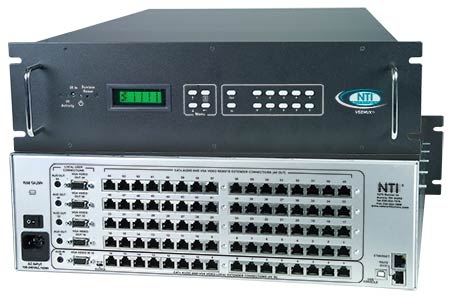Video matrix switches are designed to simplify the task of routing video signals from multiple sources, such as computers, surveillance cameras, and DVD players, to one or more display devices, such as monitors, projectors, and TVs. The benefits of deploying video matrix switches include reducing equipment costs and space needs, while giving video system designers more control and flexibility. These electronic switches are used in many applications, including: digital signage, command and control centers, boardrooms, entertainment facilities, conferences and trade shows, courtrooms, classrooms and home theaters.
Digital Signage
Using a video matrix switch in a digital signage application allows targeted messages, video content and advertisements to be displayed digitally in specific locations during particular times. Video matrix switches allow a user to independently route real-time, multi-input video and audio signals to multiple displays for the ultimate flexibility in distributing multimedia information in public venues, such as in retail chain stores, airports, museums, and banks.
Command and Control Centers
Command and control centers use video matrix switches to route multiple audio/video inputs (computers, cameras, and specialized equipment) to individual monitors or to a common display wall. Controllers can monitor data, alternate between different sources and, if needed, drive the signal to different viewing stations or send information through public address systems.
Boardrooms
Corporate boardrooms often require both fixed and portable video sources for business presentations. Video matrix switches allow the inputs from participants’ laptops to feed into the facility’s projector. Additionally, video conferencing can be incorporated with the use of video matrix switches.
Entertainment Facilities
Food and beverage outlets, such as restaurants and sports bars, often use video to bring entertainment programming to their customers. These establishments use a video matrix switch to route video and audio inputs from DVD players, cable boxes, and satellite feeds to multiple displays and speakers. In addition, surveillance camera inputs can be managed from a single security station using a video matrix switch to monitor activities at cash registers, exists, and parking lots.
Conferences and Trade Shows
At conferences and trade shows, presenters need the ability to display video material from different sources on demand. By using a video matrix switch, presenters can easily manage their video feeds to address the particular needs of audience members by switching from one video source to another as needed.
Courtrooms
Courtrooms often need the ability to present video content to different locations around the room for viewing by a judge and jury members, among others. Video matrix switches enable the quick and efficient presentation of key evidence, such as graphic reenactments of accidents or crime scenes, as well as video depositions. Courtroom security and confidentiality can be maintained in special instances, such as limited viewing by a single witness, or previewing by a judge. Video matrix switches also enable entire arrangements and bench trials to be conducted virtually.
Classrooms
Using video matrix switches in educational environments allows multiple classrooms to operate centrally located sources like VCRs or DVD players, which reduces space needs and equipment costs. Within individual classrooms, video matrix switches allow instructors to easily alternate between video sources during lessons. Even specialized equipment such as electronic whiteboards can be incorporated into the system.
Home Theater
A video matrix switch implemented in a home theater allows routing of audio and video signals from many sources (DVD player, satellite set top box, game system, etc) to multiple displays in the same room or throughout a home from a centralized location. This enables a user to eliminate multiple remote controls and easily monitor display content, while increasing the number of sources available to each display.
Network Technologies Inc (NTI) offers a variety of video-only and audio/video matrix switches to improve presentation efficiency, reduce equipment and energy costs, and maximize space usage. In order to provide innovative video matrix switch solutions, NTI invests in research and development, and performs rigorous testing on all products to ensure long-lasting and proper operation. NTI’s video matrix switches are hardware-based solutions known for their ease of use, reliability, high performance, and crisp and clear video resolutions. Video signals supported include: DVI, HDMI, VGA, S-Video, Component YPbPr video, and SDI/HD-SDI/3G-SDI. Some switches, such as the VEEMUX SM-nXm-C5AV-1000, support multiple video signals and are compatible with extenders that enable a distance of up to 600 or 1000 feet between the video source and display

